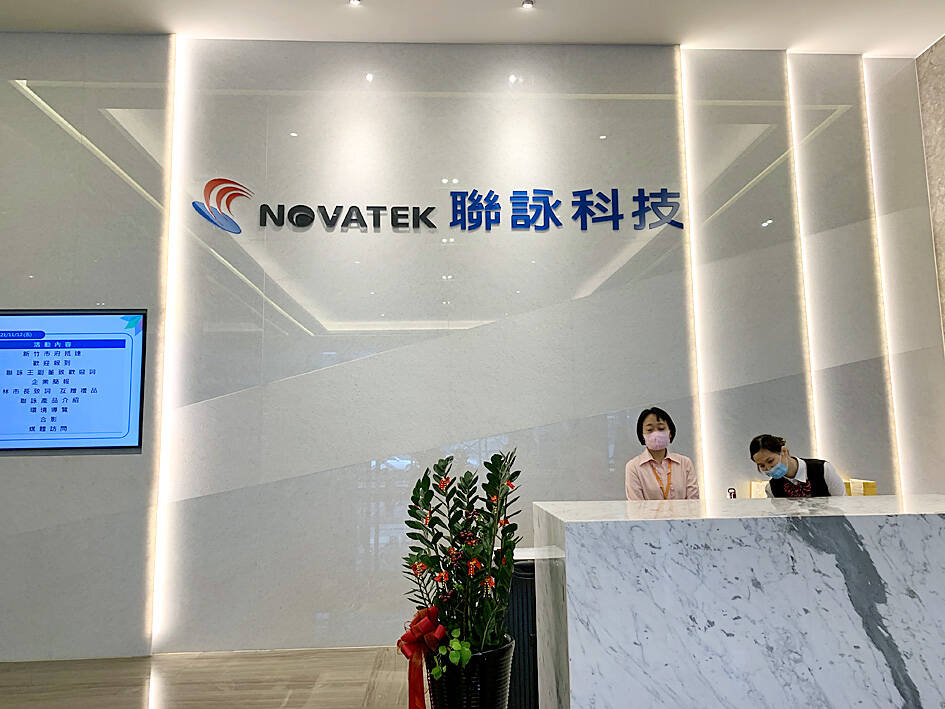Novatek Microelectronics Corp (聯詠), which makes driver ICs used in displays, yesterday gave positive guidance for this quarter, saying it expects revenue to grow by as much as 27 percent sequentially, due to inventory replenishment demand ahead of China’s June shopping season and adoption of its new high-end chips.
Revenue is expected to expand to NT$29.5 billion to NT$30.5 billion (US$960.85 million to US$993.42 million) this quarter, representing quarterly growth of 22.66 to 26.82 percent compared with NT$24.05 billion in the first three months of this year.
“After quarters-long inventory digestion in the supply chain, some of our customers have brought their inventory back to normal levels in the second quarter,” Novatek president Steve Wang (王守仁) told a virtual investors’ conference.

Photo: Grace Hung, Taipei Times
Novatek reduced its inventory to a seasonal level last quarter, Wang said.
“Chinese customers are rebuilding inventory ahead of sales promotions starting on June 18. Besides, some of our new products are entering mass production in the second quarter,” he said.
All of the company’s three major product lines would grow slightly this quarter, with small and medium display driver ICs showing the most growth, thanks to increasing demand from customers in China for OLED driver ICs used in new smartphones, Wang said.
Novatek has started shipping new display driver ICs for virtual reality devices, which would also help, he said.
Large display driver ICs would be supported by inventory replenishment demand for TV and computer display driver ICs, Wang said.
Slower growth is expected for TV system-on-a-chips, he added.
As macroeconomic uncertainty lingers, market demand visibility for next quarter is limited, but Novatek still has high hopes that the year-end shopping season will stimulate electronics sales in North America, Europe and China, he said.
Gross margin is expected to be between 38.5 percent and 40.5 percent this quarter, edging down from 41.91 percent last quarter, Novatek said.
Excluding nonrecurring engineering income and reversal of inventory write-down from last quarter’s figures, gross margin this quarter should be similar to last quarter, the company said.
An increase in shipments of high-end display driver ICs used in gaming notebook computers and monitors would help Novatek fend off headwinds better than its competitors, Wang said in response to an investor’s question about why the company was expecting a less steep decline in gross margin than its peers.
Novatek reported better-than-expected profit last quarter, with net profit expanding 17.54 percent to NT$4.75 billion, compared with NT$4.04 billion in the fourth quarter of last year. That represented an annual decline of 57.32 percent.
Earnings per share improved to NT$6.64 last quarter from NT$6.64 a quarter earlier, but declined from NT$18.3 a year earlier.
The company said that revenue and gross margin exceeded its guidance last quarter.
Novatek already performed well last month, with revenue rising to NT$9.96 billion, the highest since May last year. That represented a monthly increase of 8.5 percent from NT$9.18 billion, but an annual decline of 19.14 percent.

Taiwan Semiconductor Manufacturing Co (TSMC, 台積電) would not produce its most advanced technologies in the US next year, Minister of Economic Affairs J.W. Kuo (郭智輝) said yesterday. Kuo made the comment during an appearance at the legislature, hours after the chipmaker announced that it would invest an additional US$100 billion to expand its manufacturing operations in the US. Asked by Taiwan People’s Party Legislator-at-large Chang Chi-kai (張啟楷) if TSMC would allow its most advanced technologies, the yet-to-be-released 2-nanometer and 1.6-nanometer processes, to go to the US in the near term, Kuo denied it. TSMC recently opened its first US factory, which produces 4-nanometer

GREAT SUCCESS: Republican Senator Todd Young expressed surprise at Trump’s comments and said he expects the administration to keep the program running US lawmakers who helped secure billions of dollars in subsidies for domestic semiconductor manufacturing rejected US President Donald Trump’s call to revoke the 2022 CHIPS and Science Act, signaling that any repeal effort in the US Congress would fall short. US Senate Minority Leader Chuck Schumer, who negotiated the law, on Wednesday said that Trump’s demand would fail, while a top Republican proponent, US Senator Todd Young, expressed surprise at the president’s comments and said he expects the administration to keep the program running. The CHIPS Act is “essential for America leading the world in tech, leading the world in AI [artificial

REACTIONS: While most analysts were positive about TSMC’s investment, one said the US expansion could disrupt the company’s supply-demand balance Taiwan Semiconductor Manufacturing Co’s (TSMC, 台積電) new US$100 billion investment in the US would exert a positive effect on the chipmaker’s revenue in the medium term on the back of booming artificial intelligence (AI) chip demand from US chip designers, an International Data Corp (IDC) analyst said yesterday. “This is good for TSMC in terms of business expansion, as its major clients for advanced chips are US chip designers,” IDC senior semiconductor research manager Galen Zeng (曾冠瑋) said by telephone yesterday. “Besides, those US companies all consider supply chain resilience a business imperative,” Zeng said. That meant local supply would

Servers that might contain artificial intelligence (AI)-powering Nvidia Corp chips shipped from the US to Singapore ended up in Malaysia, but their actual final destination remains a mystery, Singaporean Minister for Home Affairs and Law K Shanmugam said yesterday. The US is cracking down on exports of advanced semiconductors to China, seeking to retain a competitive edge over the technology. However, Bloomberg News reported in late January that US officials were probing whether Chinese AI firm DeepSeek (深度求索) bought advanced Nvidia semiconductors through third parties in Singapore, skirting Washington’s restrictions. Shanmugam said the route of the chips emerged in the course of an